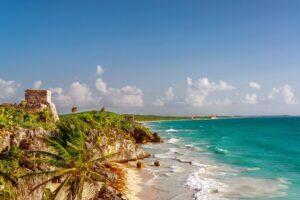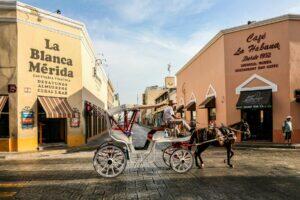Fodor's Expert Review Uxmal
Uxmal rivals Chichén Itzá, Coba, and other Maya sites in terms of its beauty and drama, but its distance from Cancún and the Riviera Maya helps assure that it is relatively less crowded. Although much of Uxmal has yet to be excavated, what is visible reflects the especially decorative style of Puuc Maya sites.
At 125 feet high, the Pirámide del Adivino is the site's most prominent structure. Unlike most Maya pyramids, which are stepped and angular, the so-called Pyramid of the Magician has a softer, more refined, round-corner design. This structure was rebuilt five times over hundreds of years, each time on the same foundation, so artifacts found here represent several kingdoms. The pyramid has a stairway on its western side that leads through a giant open-mouth mask to two temples at the summit. During restoration work in 2002, the grave of a high-ranking Maya official, a ceramic mask, and a jade necklace were discovered within the pyramid. Ongoing excavations continue to... READ MORE
Uxmal rivals Chichén Itzá, Coba, and other Maya sites in terms of its beauty and drama, but its distance from Cancún and the Riviera Maya helps assure that it is relatively less crowded. Although much of Uxmal has yet to be excavated, what is visible reflects the especially decorative style of Puuc Maya sites.
At 125 feet high, the Pirámide del Adivino is the site's most prominent structure. Unlike most Maya pyramids, which are stepped and angular, the so-called Pyramid of the Magician has a softer, more refined, round-corner design. This structure was rebuilt five times over hundreds of years, each time on the same foundation, so artifacts found here represent several kingdoms. The pyramid has a stairway on its western side that leads through a giant open-mouth mask to two temples at the summit. During restoration work in 2002, the grave of a high-ranking Maya official, a ceramic mask, and a jade necklace were discovered within the pyramid. Ongoing excavations continue to reveal exciting new finds. As with most ruins in Yucatán, climbing is prohibited.
West of the pyramid lies the Cuadrángulo de las Monjas, often considered to be the finest part of Uxmal. It reminded the conquistadores of typical convent buildings in Spain (monjas is Spanish for "nuns"). You may enter the four buildings, each comprising a series of low, gracefully repetitive chambers that look onto a central patio. Elaborate symbolic decorations—masks, geometric patterns, coiling snakes, and some phallic figures—blanket the upper facades.
Heading south, you'll pass a small ball court before reaching the Palacio del Gobernador. Covering 5 acres and rising over an immense acropolis, the palace lies at the heart of what may have been the city's administrative center. It faces east while the rest of Uxmal faces west, and archaeologists suggest this allowed the structure to serve as an observatory for the planet Venus.
The Cuadrángalo de los Pájaros (Quadrangle of the Birds) takes its name from the repeating pattern of doves that decorates the upper part of the building's frieze. In one of the building small chambers archaeologists discovered a statue of the ruler Chac (not to be confused with Chaac, the rain god), who was thought to have dwelled there.
A nightly sound and light show (8 pm April–October, 7 pm November–March) recounts Maya legends, though the spectacle is not cheap at MX$640. Still, the colored light brings out details of carvings and mosaics that are easy to miss when the sun is shining. The show is narrated in Spanish, but earphones (for an additional MX$39) provide an English translation. In summer, tarantulas are a common sight on the grounds here.
READ LESS





